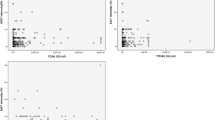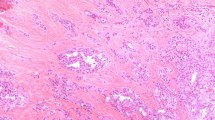Abstract
Although there are evidences of the involvement of KAP-1 in other tumors, data on differentiated thyroid carcinomas (DTC) are still lacking. We aimed to evaluate KAP-1 clinical utility in the diagnosis and prognosis of DTC. We used both visual immunohistochemistry and a semiquantitative analysis to evaluate KAP-1 expression in 230 thyroid carcinomas and 131 noncancerous thyroid nodules. There were 43 follicular carcinomas (FC) and 187 papillary thyroid carcinomas (PTC), including 130 classic (CPTC), 4 tall cells (TCPTC), and 53 follicular variants (FVPTC). Patients were followed up for 53.8 ± 41 months. They were classified as free-of-disease (142 cases) or poor outcome (25 cases—10 deaths), according to their serum Tg levels and image evidences. KAP-1 was identified in 78 % PTC, 75 % TCPTC, 74 % FC, 72 % FVPTC, 55 % FA, 44 % hyperplasia, and 11 % normal thyroid tissues. A ROC analysis identified malignant nodules with 69 % sensitivity and 75 % specificity, using a cutoff of 73.19. In addition to distinguishing benign from malignant thyroid tissues (p < 0.0001), KAP-1 expression differentiated CPTC from nodular hyperplasia (p < 0.0001), CPTC from FA (p = 0.0028), FVPTC from hyperplasia (p = 0.0039), and FC from hyperplasia (p = 0.0025). Furthermore, KAP-1 was more expressed in larger tumors (>4 cm; p = 0.0038) and in individuals who presented recurrences/metastases (p = 0.0130). We suggest that KAP-1 may help diagnose thyroid nodules, characterize follicular-patterned thyroid lesions, and identify individuals with poor prognosis.

Similar content being viewed by others
References
Li H, Robinson KA, Anton B, Saldanha IJ, Ladenson PW (2011) Cost-effectiveness of a novel molecular test for cytologically indeterminate thyroid nodules. J Clin Endocrinol Metab 96 (11):E1719-1726. doi: 10.1210/jc.2011-0459
Yassa L, Cibas ES, Benson CB, Frates MC, Doubilet PM, Gawande AA, Moore FD, Jr., Kim BW, Nose V, Marqusee E, Larsen PR, Alexander EK (2007) Long-term assessment of a multidisciplinary approach to thyroid nodule diagnostic evaluation. Cancer 111 (6):508–516. doi: 10.1002/cncr.23116
Wang CC, Friedman L, Kennedy GC, Wang H, Kebebew E, Steward DL, Zeiger MA, Westra WH, Wang Y, Khanafshar E, Fellegara G, Rosai J, Livolsi V, Lanman RB (2011) A large multicenter correlation study of thyroid nodule cytopathology and histopathology. Thyroid 21 (3):243–251. doi: 10.1089/thy.2010.0243
Yu GP, Li JC, Branovan D, McCormick S, Schantz SP (2010) Thyroid cancer incidence and survival in the national cancer institute surveillance, epidemiology, and end results race/ethnicity groups. Thyroid 20 (5):465–473. doi: 10.1089/thy.2008.0281
Ito Y, Miyauchi A, Inoue H, Fukushima M, Kihara M, Higashiyama T, Tomoda C, Takamura Y, Kobayashi K, Miya A (2010) An observational trial for papillary thyroid microcarcinoma in Japanese patients. World J Surg 34 (1):28–35. doi:10.1007/s00268-009-0303-0
SEER (2012) Cancer Statistics Review 1975–2009. http://seer.cancer.gov/csr/1975_2009_pops09. Accessed 23 June 2012
Siegel R, Naishadham D, Jemal A (2013) Cancer statistics, 2013. CA Cancer J Clin 63 (1):11–30. doi: 10.3322/caac.21166
Xing M (2010) Prognostic utility of BRAF mutation in papillary thyroid cancer. Mol Cell Endocrinol 321 (1):86–93. doi: 10.1016/j.mce.2009.10.012
Alexander EK, Kennedy GC, Baloch ZW, Cibas ES, Chudova D, Diggans J, Friedman L, Kloos RT, LiVolsi VA, Mandel SJ, Raab SS, Rosai J, Steward DL, Walsh PS, Wilde JI, Zeiger MA, Lanman RB, Haugen BR (2012) Preoperative diagnosis of benign thyroid nodules with indeterminate cytology. N Engl J Med 367 (8):705–715. doi: 10.1056/NEJMoa1203208
Ozato K, Shin DM, Chang TH, Morse HC, 3rd (2008) TRIM family proteins and their emerging roles in innate immunity. Nat Rev Immunol 8 (11):849–860. doi: nri2413[pii]10.1038/nri2413
Li X, Lee YK, Jeng JC, Yen Y, Schultz DC, Shih HM, Ann DK (2007) Role for KAP1 serine 824 phosphorylation and sumoylation/desumoylation switch in regulating KAP1-mediated transcriptional repression. J Biol Chem 282 (50):36177–36189. doi: 10.1074/jbc.M706912200
Iyengar S, Farnham PJ (2011) KAP1 protein: an enigmatic master regulator of the genome. J Biol Chem 286 (30):26267–26276. doi: 10.1074/jbc.R111.252569
Yokoe T, Toiyama Y, Okugawa Y, Tanaka K, Ohi M, Inoue Y, Mohri Y, Miki C, Kusunoki M (2010) KAP1 is associated with peritoneal carcinomatosis in gastric cancer. Ann Surg Oncol 17 (3):821–828. doi: 10.1245/s10434-009-0795-8
Hu G, Kim J, Xu Q, Leng Y, Orkin SH, Elledge SJ (2009) A genome-wide RNAi screen identifies a new transcriptional module required for self-renewal. Genes Dev 23 (7):837–848. doi: 10.1101/gad.1769609
Cammas F, Herzog M, Lerouge T, Chambon P, Losson R (2004) Association of the transcriptional corepressor TIF1beta with heterochromatin protein 1 (HP1): an essential role for progression through differentiation. Genes Dev 18 (17):2147–2160. doi: 10.1101/gad.30290418/17/2147
Cammas F, Oulad-Abdelghani M, Vonesch JL, Huss-Garcia Y, Chambon P, Losson R (2002) Cell differentiation induces TIF1beta association with centromeric heterochromatin via an HP1 interaction. J Cell Sci 115 (Pt 17):3439–3448
Nakamura Y, Yamagata T, Maki K, Sasaki K, Kitabayashi I, Mitani K (2006) TEL/ETV6 binds to corepressor KAP1 via the HLH domain. Int J Hematol 84 (4):377–380. doi: 10.1532/IJH97.06151
Rooney JW, Calame KL (2001) TIF1beta functions as a coactivator for C/EBPbeta and is required for induced differentiation in the myelomonocytic cell line U937. Genes Dev 15 (22):3023–3038. doi:10.1101/gad.937201
Beer DG, Kardia SL, Huang CC, Giordano TJ, Levin AM, Misek DE, Lin L, Chen G, Gharib TG, Thomas DG, Lizyness ML, Kuick R, Hayasaka S, Taylor JM, Iannettoni MD, Orringer MB, Hanash S (2002) Gene-expression profiles predict survival of patients with lung adenocarcinoma. Nat Med 8 (8):816–824. doi: 10.1038/nm733nm733
Silva FP, Hamamoto R, Furukawa Y, Nakamura Y (2006) TIPUH1 encodes a novel KRAB zinc-finger protein highly expressed in human hepatocellular carcinomas. Oncogene 25 (36):5063–5070. doi: 10.1038/sj.onc.1209517
Cooper DS, Doherty GM, Haugen BR, Kloos RT, Lee SL, Mandel SJ, Mazzaferri EL, McIver B, Pacini F, Schlumberger M, Sherman SI, Steward DL, Tuttle RM (2009) Revised American Thyroid Association management guidelines for patients with thyroid nodules and differentiated thyroid cancer. Thyroid 19 (11):1167–1214. doi: 10.1089/thy.2009.0110
Cunha LL, Morari EC, Guihen AC, Razolli D, Gerhard R, Nonogaki S, Soares FA, Vassallo J, Ward LS (2012) Infiltration of a mixture of immune cells may be related to good prognosis in patients with differentiated thyroid carcinoma. Clin Endocrinol (Oxf) 77 (6):918–925. doi: 10.1111/j.1365-2265.2012.04482.x
Cunha LL, Morari EC, Guihen AC, Razolli D, Gerhard R, Nonogaki S, Soares FA, Vassallo J, Ward LS (2012) Infiltration of a mixture of different immune cells may be related to molecular profile of differentiated thyroid cancer. Endocr Relat Cancer 19 (3):L31-36. doi: 10.1530/ERC-11-0285
Morari EC, Marcello MA, Guilhen AC, Cunha LL, Latuff P, Soares FA, Vassallo J, Ward LS (2011) Use of sodium iodide symporter expression in differentiated thyroid carcinomas. Clin Endocrinol (Oxf) 75 (2):247–254. doi: 10.1111/j.1365-2265.2011.04032.x
Morari EC, Silva JR, Guilhen AC, Cunha LL, Marcello MA, Soares FA, Vassallo J, Ward LS (2010) Muc-1 expression may help characterize thyroid nodules but does not predict patients’ outcome. Endocr Pathol 21 (4):242–249. doi: 10.1007/s12022-010-9137-4
Cunha LL, Morari EC, Nonogaki S, Soares FA, Vassallo J, Ward LS (2012) Foxp3 expression is associated with aggressiveness in differentiated thyroid carcinomas. Clinics (Sao Paulo) 67 (5):483–488
Ho J, Kong JW, Choong LY, Loh MC, Toy W, Chong PK, Wong CH, Wong CY, Shah N, Lim YP (2009) Novel breast cancer metastasis-associated proteins. J Proteome Res 8 (2):583–594. doi: 10.1021/pr8007368
Stroup AM, Harrell CJ, Herget KA (2012) Long-term survival in young women: hazards and competing risks after thyroid cancer. J Cancer Epidemiol 2012:641372. doi: 10.1155/2012/641372
Hirsch D, Ginat M, Levy S, Benbassat C, Weinstein R, Tsvetov G, Singer J, Shraga-Slutzky I, Grozinski-Glasberg S, Mansiterski Y, Shimon I,t Reicher-Atir R (2009) Illness perception in patients with differentiated epithelial cell thyroid cancer. Thyroid 19 (5):459–465. doi: 10.1089/thy.2008.0360
Kijanka G, Hector S, Kay EW, Murray F, Cummins R, Murphy D, MacCraith BD, Prehn JH, Kenny D (2010) Human IgG antibody profiles differentiate between symptomatic patients with and without colorectal cancer. Gut 59 (1):69–78. doi:10.1136/gut.2009.178574
Acknowledgments
We thank the State of São Paulo Research Foundation (Fapesp) for supporting this study.
Author information
Authors and Affiliations
Corresponding author
Rights and permissions
About this article
Cite this article
Martins, M.B., Marcello, M.A., Morari, E.C. et al. Clinical Utility of KAP-1 Expression in Thyroid Lesions. Endocr Pathol 24, 77–82 (2013). https://doi.org/10.1007/s12022-013-9245-z
Published:
Issue Date:
DOI: https://doi.org/10.1007/s12022-013-9245-z




